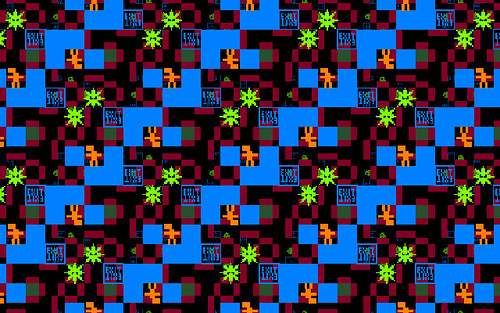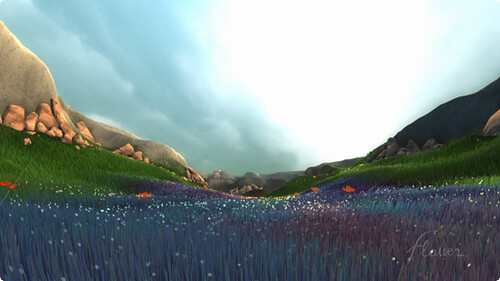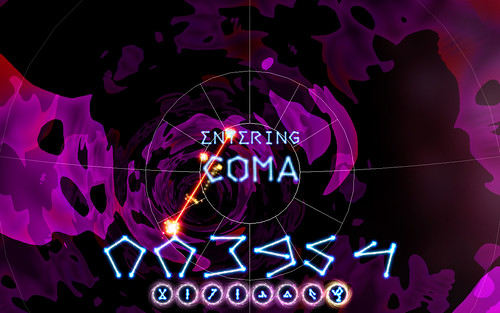Posts from ‘Abstract’ Category
Don’t Look Back
By: Derek Yu
On: March 13th, 2009
Terry Cavanagh’s Don’t Look Back is a moody platformer that’s somewhat reminiscent of games like Seiklus and Kaipuu, but is decidedly more focused and challenging. It’s a rewarding game to play for fans of the genre – I’ll leave it at that!
TIGdb: Entry for Don’t Look Back
How and Where
By: Guest Reviewer
On: March 11th, 2009
This is a guest review by Andreas Kämper.
I’d like to present two charming little games done by Mike Inel, called “How” and “Where”. I’d also like to thank KnightBlargh from the forums at this point for pointing us out to the games.
“How” is a charming little game in which you control a girl who has to put as many balls into a well as possible in five minutes. Carrying balls around uses up Stamina, while consuming the balls restores Stamina, but slowly kills the girl. While that sounds pretty bland and straightforward as a game, it’s the execution that makes this game so special. The graphics are hand-drawn and smoothly animated, creating a unique atmosphere without even using so much as sound effects or music. You just have to feel sorry for the girl when it clumsily drops to the ground of exhaustion or simply drops dead after eating too much of the spheres.
“Where” on the other hand is a 3D first person maze game. You start the game walking towards a ball of light, until a maze starts forming around you that you can then explore. If you reach the edges of the maze, you can change its layout and style, resulting in a change of color as well as music. While there is nothing much to see in the maze, save for its four different styles, the game, just as “How”, creates a unique and relaxing atmosphere. According to Mike Inel, the game has been remade once already, but was neither completely finished when it was original made, nor when he remade it.
Neither of these games offers long-lasting fun or much replayability (except for breaking the Highscore in “How” maybe) but they still should be played by anyone valuing an unique experience or taking an interest in “art games”. Some people may also be offended by the skimpiness of the girl in “How” a bit, so better skip on it if you’re that type of person.
Opera Omnia
By: Derek Yu
On: March 5th, 2009
Following the truly inspired Rara Racer comes Opera Omnia, another experimental game from the prolific Stephen “increpare” Lavelle. Like Rara, this game is hard to describe without ruining some of the interesting parts. All I’ll say is that I’m extremely impressed with how expertly Stephen joined the game’s theme and narrative with its mechanics, which are extremely counterintuitive at first. Once you wrap your head around it, though, you can’t imagine it any other way.
For me, this is an important game – if you’re not immediately taken with it, try giving it some time, because it builds up very deliberately.
TIGdb: Entry for Opera Omnia
Blueful
By: Xander
On: February 26th, 2009
Blueful is a short story by Aaron.A.Reed, designed to act as a prelude for his IF adventure Blue Lacuna. The interesting quirk of Blueful is that it takes place over a number of different websites which you navigate through your browser. It adds a certain amount of reality to the story, though sadly it does degrade the experience when a couple of the links refuse to work anymore (though a clever ‘word’ system is in place so you can skip broken chapters and carry on to the next link), however the sheer inventiveness of it all makes it worth the trouble. The ending especially sounds interesting, but whether I can even get it remains to be seen. I’m afraid closure is something you’ll have to wait for.
I’d suggest ignoring a lot of the ‘reaction’ comments on both websites if that kind of ‘This will change my life. Honestly, Thank you!’ testimonial grinds you the wrong way, but truthfully its a tough story to not enjoy given the clear amount of effort that was put into it. It’s very well thought out, and if it was partly designed to get me interested in the more complex follow-up Blue Lacuna I’d have to say its worked on me. Look forward to a review soon!
(Thanks to Fuzz in the forums!)
Jumpman
By: Derek Yu
On: February 20th, 2009
For being a platformer called “”http://forums.tigsource.com/index.php?topic=4821.msg156004#msg156004">Jumpman," this is one of the freshest games I’ve played recently. The most obvious comparison is messhof’s Punishment series, but this feels much more multidimensional (in more ways than one). There are some really interesting ideas at play here, and some of the best ones are in the later stages.
To quote the author:
Jumpman makes me think that being a character in an Atari game is like being a character in the movie Cube. Disturbing!
TIGdb: Entry for Jumpman
Flower – thatgamecompany returns to the PSN!
By: Xander
On: February 13th, 2009
Phew, finally finished ‘I wanna be the guy’! Hah, that took a whil-
Wait, it’s WHAT year now?! Well, time does fly when you’re in a sado-masochistic relationship with a video-game! Luckily I’m finished just in time for the release of Flower.
From the creators of Cloud and Flow, this is certainly an original title. It’s quite difficult to draw comparisons without either referencing TGC’s own works or the even more esoteric PSN experience Linger in Shadows. This aside, part of the enjoyment of the title definitely comes from playing the game yourself, and certainly that’s where Flower trumps its demo-scene partner. There’s a lot more interactivity involved in Flower, the rough explanation of which is that you control a petal in the countryside by utilising the motion controls of the Six-Axis controller to invoke the wind. The ‘goal’ is blow through flowers dotted around the landscape to encourage them to blossom and add their petals to your own ever-growing collection.
Its a very simple game, aided by a simple control scheme where-in every single button on the controller calls forth the wind. The motion controls are amazingly responsive, so much so that really the only thing that stops you from maneuvering your blossom-storm in fantastical formations is that your wrist might just twist itself off. Both a lack of urgency in your objectives, combined with the responsive controls provides an unparrelled relaxation experience, though that isn’t to say your role is an entirely passive one. Each environment adds slight complexities to the activity, as well as new aesthetic delights.
It’s honestly hard to explain how fantastic this game looks in motion, and the satisfaction that comes from knowing that you’re involved in the creation of the mise-en-scene is almost painfully gratifying. Whilst the spreading of beauty across occasionally barren landscapes does sound very Okami-ish, what really makes Flower special is your own emotional engagement in the scenarios. You are the one who brings life to the landscape, and so anything that happens after that fact feels like being back at play-school and having your sand castle kicked back in your own face. In Okami it feels like you’re doing a favour to the world, but in Flower everything is a matter of self. There are no other people in the game to identify with, which instead means you find yourself identifying with more abstract notions of yourself. It is quite simply, your nature.
Flower is available now on the PSN for $10/£6.29, and there’s a playable trial available if you at least happen to have access to a PS3. It’s a wonderful game, and I don’t want to say that it deserves to be played. Rather, it’s something you deserve yourselves, what with the Credit Cruch/Economic Disaster/Business Hyperbole going on, there’s just no escapism that’s quite like it!
TIGdb: Entry for fl0wer
Make My Head Grow / 4’33” of Uniqueness
By: Brandon McCartin (BMcC)
On: February 8th, 2009
Make My Head Grow is a two player competitive game of head-smashing and box-pushing, made within 48 hours, that recently cleaned up at the 2009 Nordic Game Jam. I find its gameplay remarkably disturbing.
(Thanks Renaud!)
While I’m here, I might as well post Petri‘s “experimental art game” entry (which apparently Heather and ’ Site">Cactus contributed to) called <a href=“http://www.kloonigames.com/blog/games/4mins33secs” title=“4’33” of Uniqueness">4′33″ of Uniqueness. It makes me feel a little bit sad.
Check out Kokoromi’s site for more info and also pictures as well!
Blush Prototype
By: Brandon McCartin (BMcC)
On: January 27th, 2009
Flashbang has begun production on another one of their world-famous eight-week games. This one looks to be a bit less silly than their previous entries, but no less excellent.
Be sure to check The Blurst Blog for frequent behind-the-scenes updates. (I’m talking so behind-the-scenes, they even reveal their wallpaper color picking process.) Also, check out this excellent interview with The Flashbang Hivemind up on Rock, Paper, Shotgun.
Brainpipe
By: Derek Yu
On: January 5th, 2009
Brainpipe is the latest offering from Digital Eel, best known for their Strange Adventures in Infinite Space series of games. It’s a simple, psychedelic tunnel flying game, where the goal is to collect glyphs and avoid obstacles. Every tenth glyph increases your level, and the game ends after level 10.
Using the mouse to control, you can click the left mouse button to slow down briefly. That’s all there is to it, really. The visuals of the game are good: the procedurally-generated walls and ambient music work well together and are quite pleasing to the senses. Unlike similarly trippy games like, say, Space Giraffe, Brainpipe is meant for ease of play, and not outright sensoral violation.
One thing that has to be mentioned here, because it’s (slightly irresponsibly) left out from the game, the game’s website, and the game’s readme: the demo of the game contains two fairly sedate levels (levels 1 and 3 in the full game), after which you are sent to “Coma,” an impossibly fast level with no glyphs in which you are expected to die. Without the warning, it’s pretty easy to assume that this is part of the game, as there’s no real indicator to the otherwise. I’m told the full version of Brainpipe ($15) has a much more reasonably-paced difficulty ramp. (Source: Shadowcat, via the RPS comments)
TIGdb: Entry for Brainpipe
Rara Racer, Mirror Stage Preview
By: Terry
On: December 9th, 2008

It’s very difficult to explain why you should play increpare’s Ludum Dare game Rara Racer without spoiling the whole bloody thing, and unfortunately the screenshot in the thread really doesn’t do justice to the concept. The windows download is available here, and will only take a little over two minutes and 10 seconds of your time… You just have to play it for yourself. It’s worth every second!

Also, if you’ve been following the What are you working on? thread on the forums, you might have seen a screenshot or two of increpare’s Mirror Stage, which has been in the works on and off for a couple of months now. That’s nearing completion – in fact, could quite possibly be finished this weekend. I’ve seen a few running demos at various stages of development and at TIGJam:UK, and it’s definitely one to keep an eye on! More screenshots of it after the jump:













